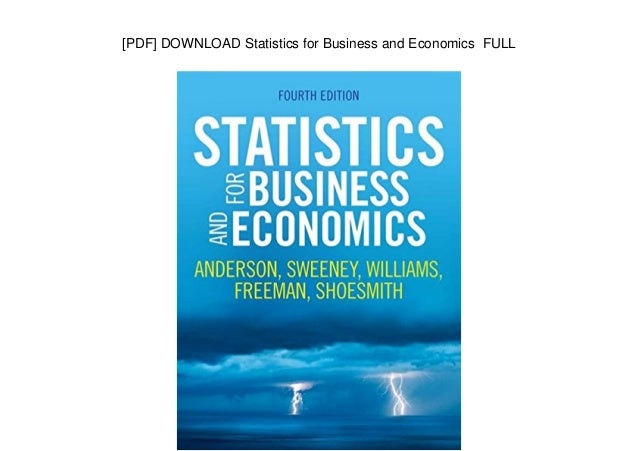
Statistics For Business And Economics Download Free PDF
Sound methodology merges with a proven problem-scenario approach, and significant applications for the most powerful approach to mastering critical statistical concepts.Download Free PDF. Statistics for Business and Economics (11th Edition) by David R.
Hateful comments or trolling will earn you a ban.Any posts/comments related to violence or threats to the school will be subject to a mute/ban. A short summary of this paper. 15 The place for all things CPP related. Whether alumni, currently a student, or planning to attend, introduce yourself, ask questions, and get to know your fellow students.With The Practice of Statistics for Business and Economics (PSBE), instructors can help students develop a working knowledge of data production and interpretation in a business and economics context, giving them the practical tools they. Publisher: Macmillan Higher Education. Page: 846Descargar Libro en PDF, eBooks, Solucionario de Statistics for Business and Economics - James T.
Appendix I: Business Report Writing 54319. Chi-Square and Other Nonparametric Tests 45018. Multiple Regression and Correlation 36816. Simple Regression and Correlation 32014. Estimating with Confidence Intervals 17213.
Measures of Central Tendency and Dispersion: Chapter 3 from Applied Statistics for Business and Economics: AnEssentials Version, Third Edition by Webster, 1998 446. Describing Data Sets: Chapter 2 from Applied Statistics for Business and Economics: An Essentials Version, Third5. The Role of Statistics: Chapter 1 from Applied Statistics for Business and Economics: An Essentials Version, Third4. Preface: Chapter from Applied Statistics for Business and Economics: An Essentials Version, Third Edition by Webster,3. Front End Paper: Chapter from Applied Statistics for Business and Economics: An Essentials Version, Third Edition by2.
Hypothesis Testing: Chapter 8 from Applied Statistics for Business and Economics: An Essentials Version, Third Edition11. Estimating with Confidence Intervals: Chapter 7 from Applied Statistics for Business and Economics: An EssentialsVersion, Third Edition by Webster, 1998 17210. Sampling Distributions: Chapter 6 from Applied Statistics for Business and Economics: An Essentials Version, Third9. Probability Distributions: Chapter 5 from Applied Statistics for Business and Economics: An Essentials Version, Third8.
Time Series and Index Numbers: Chapter 13 from Applied Statistics for Business and Economics: An EssentialsVersion, Third Edition by Webster, 1998 40216. Multiple Regression and Correlation: Chapter 12 from Applied Statistics for Business and Economics: An EssentialsVersion, Third Edition by Webster, 1998 36815. Simple Regression and Correlation: Chapter 11 from Applied Statistics for Business and Economics: An EssentialsVersion, Third Edition by Webster, 1998 32014. Analysis of Variance: Chapter 10 from Applied Statistics for Business and Economics: An Essentials Version, Third13.

The second part provides a completeAnd coherent Solution to that problem. The first is the Problem Statement thatDescribes the dilemma that must be resolved. This allows the students the opportunity toOrganize the process they can use to master the material in that chapter.Every example of the statistical tools available to business decision-makers presents aRealistic situation requiring a solution they typically face in managing a business.These examples consist of three parts. Several pedagogical characteristics described below have also been added toEnhance the instructional advantages presented in the text.This third edition of Applied Statistics for Business and Economics: An EssentialsVersion can be used effectively in either a one-semester or two-semester statistics course.While the material has been compressed to permit a streamlined discussion typical of aOne-semester course, topical coverage remains sufficient to challenge even those studentsWho complete their initial exposure to statistical analysis in a two-semester sequence.Below is a brief description of pedagogical features contained in this edition.Each chapter opens with a flowchart showing the main topics to be covered and theManner in which they are interrelated. Further, the presentation has been condensed to present the material in a more concise and compliantForm.
Without this important skill, decision-makers are grossly disadvantaged in their efforts to manage a business.Each chapter also concludes with problems and elaborate solutions that reinforce theStatistical tools presented in that chapter. Appendix I describes and illustrates the manner in which a businessReport must be prepared in order to communicate essential proposals and recommendations to others who are interested in the results. In order for a business to functionAs a unit, the individuals within that business must be able to communicate their ideasAnd thoughts. A Procedure for Business Report WritingCommunication in business is inarguably essential. ItDoes no good for students to solve a problem if they do not understand what that solution means.
This provides immediate feedback as to whether the students sufficientlyComprehend the material in that section before proceeding on to the next.Each chapter opens with a short narrative called Setting the Stage that presents a realistic case that can best be addressed using the statistical tools contained in the chapter.The nature of the problem that must be resolved is described and thus provides theStudents with a foundation upon which to base their readings and examination of theA short section at the close of each chapter entitled Curtain Call refers the studentsBack to Setting the Stage. Again, these problems are of an applied nature that clearly demonstrateHow statistics can aid in the business decision-making process.Following each section within each chapter are several exercises the students mustSolve that reinforce their understanding of the material to which they have beenExposed. This provides the students with a realistic situationRequiring the applications of the statistical techniques to the computer-based data set.At the end of each chapter there is an ample supply of problems with a varying degreeOf difficulty that allow the students the opportunity to sharpen and refine their statistical skills. Each chapter provides the students with a problem they must solve based on the data in one of those files with the aid of the statistical tools discussed in that chapter. Computer printouts with emphasis on Minitab and Excel are presentedAlong with a discussion of their important features.The text comes with data disk containing several data files that can be accessed inMinitab, Excel, and ASCII formats.


 0 kommentar(er)
0 kommentar(er)
